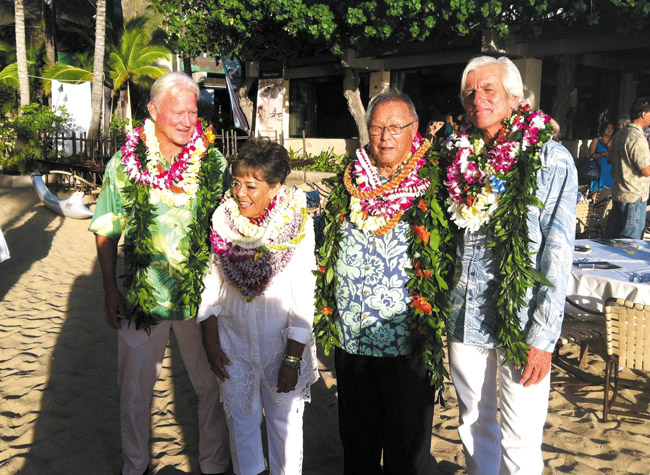Waterman Hall Of Fame Welcomes Five
A gentle mist fell as a potent south swell rolled into Waikiki, creating a breathtaking backdrop. It was as if the ocean gods were welcoming some of Hawaii’s modern-day legends of the sea.
Several hundred people gathered at Outrigger Canoe Club for the 2014 Hawaii Waterman Hall of Fame Awards Dinner. This year, five outstanding kane a me na wahine o ke kai (men and women of the sea) were honored for their achievements in and out of the water.
Moments before the festivities started, a large Hawaiian monk seal cruised past the Elks Club and surfaced outside Outrigger Canoe Club. As quickly as it arrived to say aloha to those being recognized, it disappeared into the surf.
It was the perfect start to a grand celebration.
“Dad” Center
One-by-one, women crews raced around Portlock Point and headed toward Outrigger Canoe Club. The eight-mile sprint from Hawaii Kai to Kaimana Beach is the final leg of the Dad Center Canoe Race. The event is held each year in honor of one of Hawaii’s greatest athletes, coaches and mentors, George David “Dad” Center.
Center was an accomplished swimmer, paddler and volleyball player who later coached hundreds of men and women in those sports as well as track. The highlight of his long coaching career came in 1920, when he guided the U.S. Swim Team in the Olympics, where Duke Kahanamoku won gold medals in the 100-meter freestyle and relay.
Mark Cunningham
“When Mark Cunningham was in the tower, all was good,” says Outrigger Duke Kahanamoku Foundation president Billy Philpotts. “You knew you were safe.”
But Cunningham’s accomplishments went far beyond his lifesaving skills on Oahu’s North Shore. The Punahou graduate was the ultimate champion bodysurfer, winning more than 15 titles. He was a wave-riding master at the break he watched over for more than 20 years — world-famous Pipeline.
“I’m here today because of the many great watermen and waterwomen who came before me,” says Cunningham, who enjoyed a 30-year career with the City and County of Honolulu’s Ocean Safety and Lifeguard Services Division.
Cunningham also recognized the importance of preparing for the future while embracing the past. He founded the Oahu Junior Lifeguard Program, providing lifesaving skills to Hawaii’s youths. He also was a community environmentalist who fought to protect the North Shore from large-scale development, founding Defend Oahu Coalition, an organization inspired by the concept “Keep the Country Country.”
Anona Napoleon
“The reason I stand before all of you tonight is because of the men in my life, including my husband Nappy,” says Anona Napoleon. “This year we celebrate our 50th anniversary! Thank you for 50 wonderful years.”
It is no surprise Napoleon credits family for her success — the Napoleons always have been about ohana. She and Nappy have touched the lives of thousands of people. But long before she was teaching people to paddle at Anuenue Canoe Club, she was making headlines as a champion waterwoman. She won the International Makaha Surfing Contest in 1961 and narrowly missed making the Olympic team in kayaking in 1960 and 1964.
She was on the first women’s crew to cross the Ka’iwi Channel in 1975, and did it again in 1979 for the first Na Wahine O Ke Kai Race. She is a trailblazer, a matriarch and a true champion of the sea.
Randy Rarick
Randy Rarick raced down the line at Queen’s Surf fronting the Duke Kahanamoku statue and smoothly tucked into a small barrel. Rarick was one of several “legends” who took part in the 2014 Duke’s OceanFest, still silky smooth after all these years.
Rarick made a name for himself in the 1970s as a surfer and a shaper, and eventually became one of the most influential proponents of professional surfing.
“Where would we be if Randy Rarick wasn’t in our lives?” asks Philpotts. “He was the paragon of the competitive surfing community, elevating professional surfing internationally.”
“I’m humbled to be here and honored to be a part of this class,” Rarick says with deep appreciation.
“Sonny” Tanabe
Melbourne, Australia, is a long way from Hilo — just ask Richard “Sonny” Tanabe.
Who knew that a barefoot boy who learned to swim in Hilo Bay would one day compete in the 1956 Olympics. And trust me, Tanabe was truly a small-town boy.
“I didn’t know who Duke Kahanamoku was,” admits Tanabe. “I never heard of him.”
But that would change. Tanabe would become an All-American at Hilo High School, and later starred at Indiana University.
Tanabe returned home to share his knowledge with students at Kamehameha Schools, where he taught and coached swimming and water polo for 33 years. He also made his mark as a water safety instructor with American Red Cross for 30 years, and later become an author, sharing his passion for spearfishing and free diving in two award-winning books, Spearfishing on the Island of Hawaii and The Evolution of Freediving.
“I have a lot to be thankful for,” says Tanabe.
rkmizutani@gmail.com






